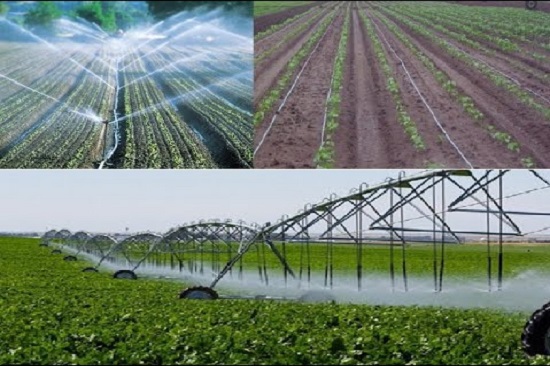| News Details |
Water resources management and legalization in some modern irrigation systems
2023-05-24

Dr. Ihab Mohammed Al-Shabani
Ministry of Agriculture - Agricultural Research Department
Preface:
Water resources are one of the main determinants of agricultural production and development, especially in the arid and semi-arid areas in which Iraq is located, which are characterized by low rainfall, high temperatures and high evaporation rates that exceed precipitation rates. The sharp decline in the annual water import rates of the Tigris and Euphrates rivers and their fluctuation from season to season have greatly affected the degradation of these resources. Therefore, the use of available water was a real goal that must be focused on in order to exploit the largest area of ??arid and semi-arid lands in the development of sustainable agriculture. The aforementioned description of the current and future water situation calls for exploration of non-traditional means to bridge the gap between available fresh water on the one hand and food security on the other.
First / the concept of water management:
Water management is defined as the skill in using and employing all natural, chemical, biological and social resources to provide crops with their water needs to obtain food and feed to achieve predetermined goals without harming the environment. It is a set of processes by which water is controlled and used in order to obtain food or yield and feed in its ideal form, and the amount of water needed and the date of irrigation depend on the prevailing climatic conditions, the type of crop and the degree of its growth. The Caring for water resources is vital and important to cover all human needs of drinking water and industrial needs and to secure the requirements of irrigated agriculture, as water is considered a commodity that has an economic value that can be traded internationally and for export and import like any of its counterparts, and the economic concept of water may lead to the creation of mutual global and regional markets for this commodity important strategy.
Second / water rationing:
It is defined as the amount of cubic meters needed to irrigate a particular crop one irrigation, and the theoretical water metering is the amount of water needed to irrigate an area to produce the best crop for any type of agriculture without losing anything of this water. The sources of water loss can be summarized as follows:
1. (Soil Moisture Evaporation) evaporation from the soil surface.
2. Seepage into the depths of the soil beyond the limits of the root zone.
3. Side run (runoff).
Third: surface drip irrigation:
The surface drip irrigation system is one of the most important modern irrigation systems that are reliable in rationalizing the use of water, starting with controlling the evaporation of water due to transportation due to the nature of this system, it transports water through a network of closed pipes that ends with devices called drippers, leading to providing plants with water in a way that ensures the employment of irrigation water within the boundaries of the root zone safely. To compensate for the lack of soil moisture during a certain water stress period and to control a constant level of soil moisture at the root zone borders of all plants according to the development of their growth stages, in addition to reducing the irrigated area compared to other irrigation systems, the drip irrigation system irrigates certain areas of the total area of ??the field ( areas under the vegetable canopy of the crop) and this reduces evaporation, surface runoff, and water sinking, and achieves the highest irrigation efficiency.
The following are the most important features of the surface drip irrigation system:
Advantages:-
1- Significant savings in the amount of water used to irrigate plants, as this system requires less water compared to other traditional methods.
2- Reducing water loss as a result of evaporation from the surface of the soil or seepage into the depths.
3- Saving operating costs to a minimum, and this is represented by not needing a lot of manpower, and reducing the energy consumed for pumping irrigation water.
4- Increasing the productivity of the cultivated area, as the principle of drip irrigation is based on retaining moisture in the area surrounding the roots of plants, which enhances and improves their growth.
5- Reducing the growth of harmful and unwanted weeds; This is because drip irrigation depends on irrigating specific areas of the soil only, and not wetting the entire surface of the soil, which will reduce the chances of these weeds growing.
6- Protecting the soil from erosion or erosion compared to other traditional methods.
7- Reducing the spread of fungal diseases that may affect plants.
8- Drip irrigation is one of the easy-to-install systems that do not need to dig foundations for it, but only work on laying pipes in the targeted areas, and this system is characterized by the possibility and ease of moving it from one place to another.
9- Reducing, as much as possible, the loss of fertilizers and nutrients that are added to the soil.
10- The possibility of using this system to irrigate fields and irregular soils, without the need to level them. Possibility of using waste and recycled water to irrigate plants.
11- Regulating the use of water and distributing it according to desire, by controlling the quantities of water that comes out. from each dripper, making the efficiency of this system range between 85-90%.
Fourth: Sub-surface drip irrigation system:
The subsurface drip irrigation system is one of the economical methods in arid regions, as it is characterized by high efficiency in the use of irrigation water, in which water is added directly to the root spreading area, and this helps the roots to spread over a larger area, and this system is also characterized by the absence of water evaporation from the soil surface, And the lack of deep penetration outside the boundaries of the root zone, and some studies have shown that this system saves 25-50% of the water used in drip irrigation, achieves higher water use efficiency compared to surface irrigation, and increases crop yields.
There are some advantages of subsurface drip irrigation, including:
1- It reduces water loss rates by evaporation.
2- Suitable for deep, even soils.
3- It reduces the processes of breaking soil structure and thus reduces the deterioration of its physical properties.
4- It reduces the spread of bush seeds, which reduces the cost of controlling them.
5- Plant response to subsurface irrigation is generally good.
6- It operates at low operating pressures, which saves operating energy in relation to the area of ??the system.
7- It is considered one of the best irrigation systems suitable for conservation agriculture, as it moisturizes the soil in various directions from the dripping source (dripper' flask, earthenware jar).
8- No deposition of salts at the nozzles of the dripper and its clogging, since the dripper is buried under the surface of the soil, which prevents the evaporation of water from the opening of the dripper.
Fifth /
From the above, it was found that the fixed surface and subsurface drip irrigation systems provide a number of technical, administrative and economic facilities in the management of modern irrigation systems, especially in semi-arid regions. Their use in irrigating strategic crops, in addition to the high results provided by these systems with regard to rationalizing the use of water and soil characteristics on the one hand, and growth and production qualities as a quantity and type on the other hand.
#university_of_anbar
#Upper_Euphrates_Basin_Developing_Center










